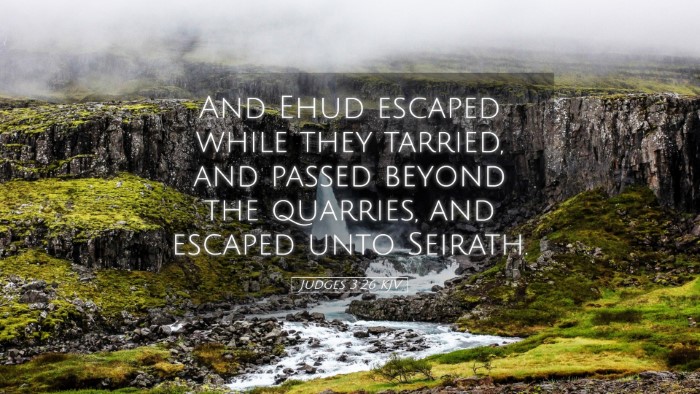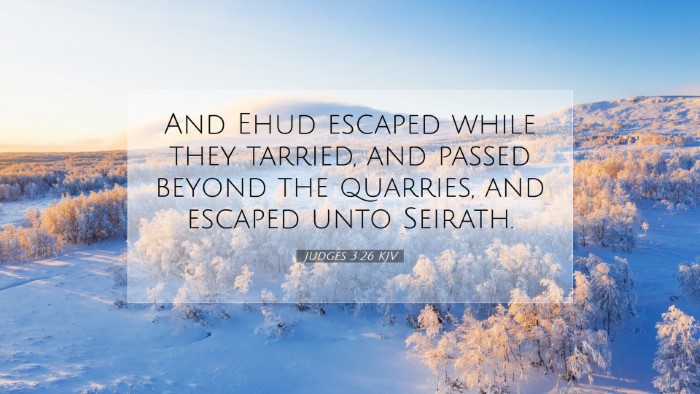Bible Commentary on Judges 3:26
Judges 3:26 narrates a crucial moment in the life of Ehud, a judge of Israel, and explores themes of divine deliverance, human agency, and the complex interplay of politics and faith in the life of God's people.
Text of the Verse
Judges 3:26 (KJV): "And Ehud escaped while they tarried, and passed beyond the quarries, and escaped unto Seirath."
Introduction
The context of this verse is the story of Ehud, who was raised up by God to deliver the Israelites from the oppression of Eglon, the king of Moab. This passage highlights the importance of divine intervention and human action as critical elements in the narrative unfolding in the Book of Judges. Commentators like Matthew Henry, Albert Barnes, and Adam Clarke offer rich insights into the significance of this verse within the larger context of Israel's history.
Commentary Insights
Human Agency and Divine Purpose
Matthew Henry emphasizes the role of Ehud as an instrument of God's will. He notes that Ehud’s act of delivering Israel was not merely based on human ingenuity but was aligned with God's divine purpose. This suggests that while humans must act, it is ultimately God who orchestrates events for His glory and the fulfillment of His promises.
The Significance of Escaping
Albert Barnes comments on the escape of Ehud as a critical moment that symbolizes God’s protection over His chosen instrument. It not only signifies survival but also represents the success of God’s plan. Ehud’s flight indicates a shift in power dynamics and foreshadows the liberation of the people of Israel from Moabite oppression. The act of escaping serves as a metaphor for spiritual deliverance as well, where believers are called to flee from sin and embrace divine guidance.
The Quarries and Their Symbolism
Adam Clarke provides an analysis of the geographical features mentioned in the passage. The 'quarries' serve as a strategic point of egress for Ehud. He points out that these locations are often places of refuge that symbolize transitions from danger to safety. This imagery can be reflective of the believer's journey from the perils of sin to the security found in God’s sanctuary.
Contextual Framework
Before diving deeper into this verse, understanding its placement within the Book of Judges is crucial. This book recounts a cycle of sin, oppression, repentance, and deliverance. Ehud’s deliverance of Israel from Eglon’s tyranny represents a pivotal restoration of God’s favor towards His people. Thus, Judges 3:26 is a conclusion of one chapter and an opening to the next phase of God’s salvific plan for Israel.
The Role of Delay
Henry speaks to the significance of the delay of the guards. Their tarrying not only allows Ehud to escape but can also be seen as a sign of their complacency and underestimation of the situation. This delay is a divine orchestration enabling the fulfillment of God's plan. It serves as a reminder that God can use the inactivity or misjudgment of others to bring about His will.
Lessons for Today’s Believers
- Trust in Divine Timing: The interplay of human action and divine providence calls for believers to trust God's timing in their lives.
- Courage to Act: Like Ehud, believers are called to take courageous actions grounded in faith, even when the situation seems dire.
- Spiritual Escape: The symbolic act of escaping from oppressive circumstances challenges believers to seek liberation not only from sin but also from spiritual bondage.
- Understanding God’s Deliverance: The narrative encourages believers to recognize and celebrate God's deliverance in their own lives and the broader community.
Conclusion
Judges 3:26 encapsulates both a moment of personal triumph for Ehud and a broader theological message about God’s capability to deliver and protect His people. Commentaries from distinguished authors like Matthew Henry, Albert Barnes, and Adam Clarke collectively enhance the understanding of this passage, allowing contemporary readers—pastors, students, theologians, and scholars—to approach the text with a rich historical and spiritual perspective.


